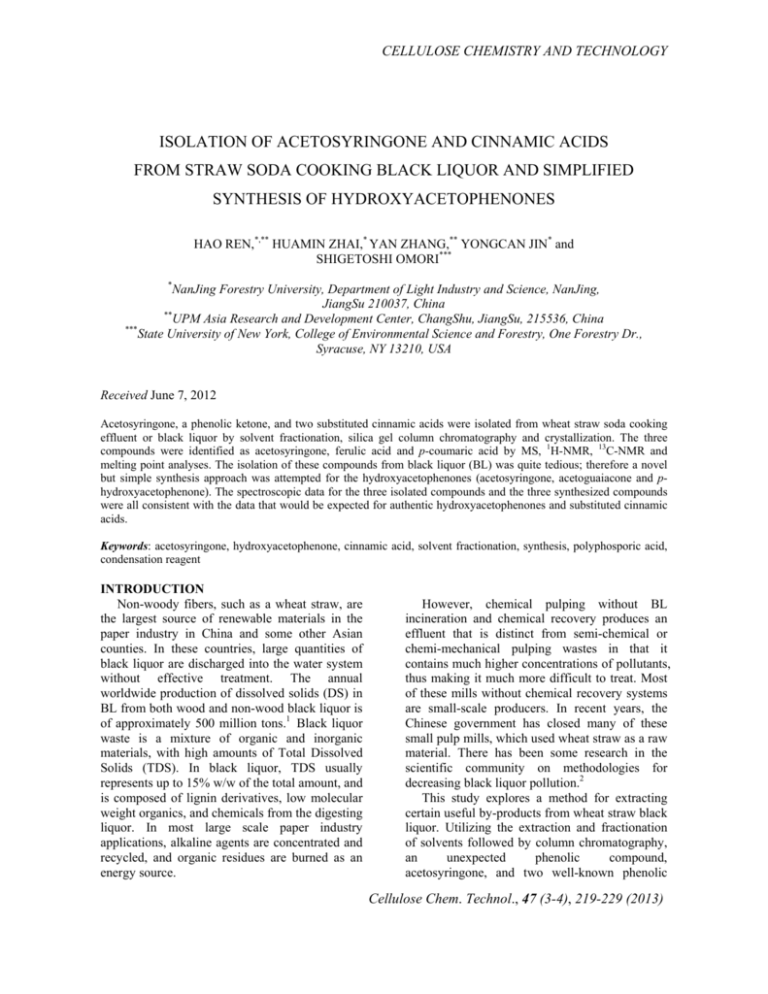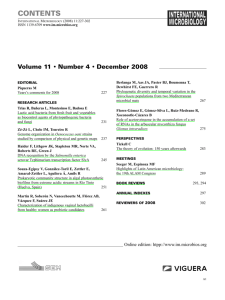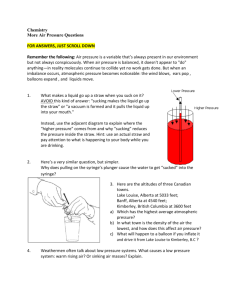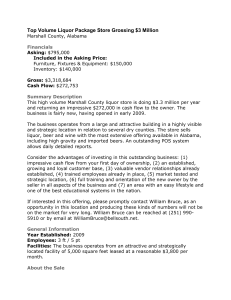isolation of acetosyringone and cinnamic acids from straw soda
advertisement

CELLULOSE CHEMISTRY AND TECHNOLOGY ISOLATION OF ACETOSYRINGONE AND CINNAMIC ACIDS FROM STRAW SODA COOKING BLACK LIQUOR AND SIMPLIFIED SYNTHESIS OF HYDROXYACETOPHENONES HAO REN,*,** HUAMIN ZHAI,* YAN ZHANG,** YONGCAN JIN* and SHIGETOSHI OMORI*** * NanJing Forestry University, Department of Light Industry and Science, NanJing, JiangSu 210037, China ** UPM Asia Research and Development Center, ChangShu, JiangSu, 215536, China *** State University of New York, College of Environmental Science and Forestry, One Forestry Dr., Syracuse, NY 13210, USA Received June 7, 2012 Acetosyringone, a phenolic ketone, and two substituted cinnamic acids were isolated from wheat straw soda cooking effluent or black liquor by solvent fractionation, silica gel column chromatography and crystallization. The three compounds were identified as acetosyringone, ferulic acid and p-coumaric acid by MS, 1H-NMR, 13C-NMR and melting point analyses. The isolation of these compounds from black liquor (BL) was quite tedious; therefore a novel but simple synthesis approach was attempted for the hydroxyacetophenones (acetosyringone, acetoguaiacone and phydroxyacetophenone). The spectroscopic data for the three isolated compounds and the three synthesized compounds were all consistent with the data that would be expected for authentic hydroxyacetophenones and substituted cinnamic acids. Keywords: acetosyringone, hydroxyacetophenone, cinnamic acid, solvent fractionation, synthesis, polyphosporic acid, condensation reagent INTRODUCTION Non-woody fibers, such as a wheat straw, are the largest source of renewable materials in the paper industry in China and some other Asian counties. In these countries, large quantities of black liquor are discharged into the water system without effective treatment. The annual worldwide production of dissolved solids (DS) in BL from both wood and non-wood black liquor is of approximately 500 million tons.1 Black liquor waste is a mixture of organic and inorganic materials, with high amounts of Total Dissolved Solids (TDS). In black liquor, TDS usually represents up to 15% w/w of the total amount, and is composed of lignin derivatives, low molecular weight organics, and chemicals from the digesting liquor. In most large scale paper industry applications, alkaline agents are concentrated and recycled, and organic residues are burned as an energy source. However, chemical pulping without BL incineration and chemical recovery produces an effluent that is distinct from semi-chemical or chemi-mechanical pulping wastes in that it contains much higher concentrations of pollutants, thus making it much more difficult to treat. Most of these mills without chemical recovery systems are small-scale producers. In recent years, the Chinese government has closed many of these small pulp mills, which used wheat straw as a raw material. There has been some research in the scientific community on methodologies for decreasing black liquor pollution.2 This study explores a method for extracting certain useful by-products from wheat straw black liquor. Utilizing the extraction and fractionation of solvents followed by column chromatography, an unexpected phenolic compound, acetosyringone, and two well-known phenolic Cellulose Chem. Technol., 47 (3-4), 219-229 (2013) HAO REN et al. acetone was recovered. The remaining filtrate was then extracted three times with ethyl acetate. The three ethyl acetate extracts were combined and washed with water once, then dried over sodium sulfate anhydrous. After one day, it was filtered and evaporated using a rotary evaporator and the target fractions were collected (Fig. 1). compounds were isolated in moderate yields. The synthesis of hydroxyacetophenones (acetosyringone, acetoguaiacone and p-hydroxyacetophenone) was also investigated to see if a novel synthesis approach could be a credible substitute for the tedious processing associated with the recovery and purification from black liquor. The synthesis approach involved condensation between acetic acid and phenol or methoxyl substituted phenols. Isolation of acetosyringone by column chromatography The liquid sample described above (5 batch materials combined) was charged on silica gel (230~400 mesh) column (4.5x25 cm) and eluted with hexane-acetone (gradient 2:1 to 1:1 v/v) and fractionated to F1-F20 (collected 200 ml each fraction). The F4-F11 was re-chromatographed using a glass column (2x40 cm, silica gel 230-400 mesh) and eluted with methylene chloride–methanol (gradient 20:1 to 10:1 v/v) and fractionated to F’1-F’14 (100 ml each). From F’3-F’6, a crystal was produced and collected (Sub-1). The yield was 620 mg. The F’7-F’10 was chromatographed again by silica gel column (2.5x40 cm) and eluted with hexane–acetone (gradient; 3:1 --> 2:1, --> 1.5:1 v/v) and fractionated to F”1-F”16 that was collected from 100 ml of each fraction. From F”7F”9, a compound was crystallized with methanol and filtrated (1st). The filtrate was allowed to stand overnight in methanol. Another crystal was produced and filtrated (2nd). The crystallization procedure for the filtrate repeated for 7 times. The crystallization procedure 1-3 yielded Sub-2 (yield: 460 mg) and crystallization procedure 4-7 yielded Sub-3 (yield: 910 mg). Both Sub-2 and Sub-3 were repeatedly recrystallized from methanol–water and acetone–water and purified. It was more efficiently purified if these crystals were chromatographed by silica gel column (solvent: hexane–ethyl acetate–acetic acid, 10:3:0.1). EXPERIMENTAL Cooking raw material Air-dried wheat straw (Triticum vulgaris) was used, with the following composition: 75.9% holocellulose, 39.6% α-cellulose, 17.7% lignin, 4.2% extractives (ethanol-benzene) and 6.5% ash. All methods were based on Tappi Standards. Soda cooking of wheat straw and its fractionation Wheat straw (moisture content 10%) was chopped to 2-3 cm in length and cooked with a 2% sodium hydroxide solution (straw to liquid ratio 1:7 w/v) at 121 °C for 2 hours. The amount of straw used in each run was 300 g on an oven-dried (OD) basis. After cooling down the cooked slurry, the pulp (solid part) was filtrated and washed with hot water three times. The filtrate and washing liquor were adjusted to pH 3.5-4 and allowed to stand for some time. Then the mixture was centrifuged to remove the precipitates (PPT-1). The remaining liquor was concentrated to a volume between 500 and 1000 ml, then acetone (1:1 v/v) was added while stirring. It was allowed to stand to produce a precipitate (PPT-2), which was recovered by filtration using a Buchner funnel and filter paper. The filtrate from PPT-2 was evaporated and the Wheat Straw Soda Cooking Solution Solid (Pulp) pH 3.5-4.0 Solution PPT-1 Evaporation to 0.5-0.7 L Add Acetone Solution PPT-2 Extraction with Ethyl Acetate Insoluble Sol 220 Figure 1: Flow sheet of solvent fractionation Wheat straw Synthesis of hydroxyacetophenones Synthesis of acetosyringone (SAS) Phosphorous pentoxide (60 g) was added to phosphoric acid (60 g) and shaken until it became clear, then 2,6-dimethoxyphenol (7.7 g) in acetic acid (4.5 g) was added to them. The mixture was heated for 30 minutes while stirring in a water bath (95 °C). After cooling, 500 mL of water was added and the mixture was transferred to a 1 L separation funnel and extracted three times with ethyl ether. The extract was combined and washed once with water and dried overnight with sodium sulfate anhydrous. After evaporating the solvent, the remainder was dissolved in a small amount of methanol and left overnight. A crystal was produced, with a yield of about 30%. Mp: 120-121 °C. If the mother liquor was chromatograhed by silica gel column (solvent: hexane–ethyl acetate, 2:1), additional crystals could be obtained. Synthesis acetoguaiacone (SAG) Phosphorous pentoxide (60 g) was added to phosphoric acid (60 g) and shaken until it became clear, then guaiacol (6.2 g) in acetic acid (4.5 g) was added to them. The mixture was heated for 30 minutes while stirring with a magnetic stirrer in a water bath (95 °C). After cooling, 500 mL of water was added and the mixture was transferred to a 1 L separation funnel and extracted three times with ethyl ether, then the extract was combined and washed with water once. The extract was dried with sodium sulfate anhydrous. After filtration and evaporation of the solvent, the remainder was chromatographed using a silica gel column (solvent: hexane–ethyl acetate, 3:1). From the main fraction, the target compound was crystallized from water, yield: 57%, mp: 114-115 °C. Synthesis of p-hydroxyacetophenone (SPHA) Phosporous pentoxide (60 g) was added to phosphoric acid (60 g) and shaken until it became clear, then phenol (4.7 g) in acetic acid (4.5 g) was added to the mixture and it was heated for 30 minutes while stirring with a magnetic stirrer in a water bath (95 °C). After cooling, 500 ml of water was added and the mixture was transferred to a 1 L separation funnel and extracted three times with ethyl ether. The extract was combined and washed with water once and dried overnight with sodium sulfate anhydrous. After filtration and evaporation of the solvent, the remainder was chromatographed using a silica gel column (solvent: hexane–ethyl acetate, 4:1, v/v) and the main product was collected, yield: 28%, mp: 112-113 °C. Melting point measurement Melting points were measured by a Fisher-Johns Melting Point Apparatus (Series No. 4006, Fisher Scientific Co.). Mp. for Sub-1: 126-127 °C; Sub-2: 218-220 °C; Sub-3: 167-170 °C. Mp. for synthesized acetosyringone (SAS): 126-127 °C, acetoguaiacone (SAG): 114-115 °C, p-hydroxyacetophenone (SPHA): 112-113 °C. Mass spectra (MS) Using direct introduction, the mass spectra (MS) of solid Sub-1, Sub-2, Sub-3, SAS, SAG, and SPHA were measured with a Thermo Polarus Q Ion Trap GC/MS Apparatus at 75 eV and at the minimum temperature (source temperature: 170 °C, sample temperature: 180 °C) required for volatilization. NMR spectra Acetone-d6 (d, 99.9%) (Cambridge Isotope Laboratories, Inc.) was used as a solvent for Sub-1, Sub-2, Sub-3. Chloroform-d was used for SAS, SAG, and SPHA. 10 mg of Sub-1, Sub-2, and Sub-3 were put into a measurement tube and dissolved in 0.5 ml acetone-d6 for analysis. 20 mg of SAS, SAG and SPHA were dissolved in 0.5 ml chloroform-d. They were measured using a Bruker AVANCE III 600 spectrometer (600 MHz 1H frequency). RESULTS AND DISCUSSION According to Fig. 1, Sub-1, Sub-2 and Sub-3 were fractionated and isolated using column chromatography from soda cooking black liquor of wheat straw. SAS, SAG and SPHA were synthesized and purified as described above. Melting point, MS (Fig. 2), and NMR (Figs. 3-6) spectra were measured for Sub-1, Sub-2, Sub-3, SAS, SAG and SPHA, respectively. Sub-1: Mp: 126-127 °C, MS (m/z); 196 (M+), 181 (M+-CH3), 153 (181-CO), 1H-NMR (600 MHz, Acetone-d6): δ (ppm): 2.05 (Acetone-d6), 2.52 (3H, s, -(CO)CH3), 3.89 (6H, S, -OCH3×2), 7.25 (2H, s, Ar-CH-×2), 7.95 (1H, S, Ar-OH×1). 13 C-NMR (150 MHz, Acetone-d6): δ (ppm): 25.42 (methyl on –CO-CH3 group), 55.84 (methoxyl group), 106.25 (Ar-2,6 C), 128.38 (Ar1 C), 141.01 (Ar-4 C), 147.53 (Ar-3,5 C), 195.39 (-CO-). 13C-NMR data were matched with the synthesized acetosyringone (SAS) data. The mixed examination between Sub-1 and synthesized SAS did not show the depression of the melting point. These results identified Sub-1 as acetosyringone (Ia) (Fig. 7). Sub-2: Mp: 218-220 °C, MS (m/z): 164 (M+), 147 (M+-OH), 119 (M+-COOH and 147-CO), 107 (119–CH+1), 91 (107–O), 77 (91–CH–1). These data matched with the MS data of the AIST database. 1 H-NMR (600 MHz, Acetone-d6): δ: 2.052 (Acetone-d6), 6.339 (1H, d, Jαβ=15.91, side chain β, -C=CH-COO-×1), 6.899 (2H, J= 8.58, Ar-Hx2), 221 HAO REN et al. Sub-3: Mp: 167-170 °C, MS (m/z): 194 (M+), 179 (M+-CH3), 177 (M+-OH), 151 (179-CO), 133 (177-COOH+1). 1 H-NMR (600 MHz, Acetone-d6): δ (ppm): 2.05 (Acetone-d6), 3.93 (3H, s, methoxy), 6.366.39 (1H, d, side chain β, =CH-CO Jαβ=15.903), 6.87-7.33 (3H, Ar–CH×3), 7.59-7.62 (1H, d, side chain α, -CH=, Jαβ=15.903). When the chart was expanded, an Ar-OH peak was detected at δ: 8.38 and a COOH peak at δ: 10.23. 7.547 (2H, J=8.58, Ar-Hx2), 7.620 (1H, d, Jαβ=15.94, side chain α, Ar-CH=C-COO-x1). 13 C-NMR (150 MHz, Acetone-d6): δ (ppm): 115.71 (Ar-3,5 C), 116.65 (methine neighbored carboxylic acid, side chain β-position), 127.09 (Ar-1 C), 130.68, 130.88 (Ar-2,6 C), 145.64 (methine on side chain α position), 160.45 (Ar-4 C), 168.29 (COOH), 206.23 (2nd peak of acetone d6). 1H-NMR data matched with those of R. Kort et al. for tran-p-coumaric acid.3 These results indentified Sub-2 as p-coumaric acid (II) (Fig. 7). SUB-1 #83 RT: 1.79 AV: 1 SB: 14 4.69-5.03 NL: 7.92E5 T: + c Full ms [ 50.00-1000.00] 181 100 95 90 85 80 75 70 Relative Abundance 65 60 196 55 50 45 40 35 30 25 20 15 5 0 153 65 10 67 63 68 53 54 60 77 79 76 70 85 80 86 93 97 98 108 110 90 100 123 125 135 138 140 121 110 120 130 m/z 140 182 154 151 156 162 167 171 150 160 179 170 180 197 183 198 195 190 207 200 SUB-2p #151 RT: 3.22 AV: 1 SB: 14 4.71-5.03 NL: 4.29E5 T: + c Full ms [ 50.00-1000.00] 164 100 95 90 85 80 75 163 70 Relative Abundance 65 60 55 50 91 45 40 147 35 119 30 25 118 20 65 15 165 63 10 5 62 56 61 80 66 67 0 60 107 89 77 70 75 108 93 94 95 81 86 88 80 90 103 100 109 117 110 121 123 120 m/z 222 148 120 146 144 136 129 130 140 149 150 157 161 160 166 171 170 177 Wheat straw SUB-3 #110 RT: 2.26 AV: 1 NL: 1.51E6 T: + c Full ms [ 50.00-1000.00] 194 100 95 90 85 80 75 70 Relative Abundance 65 60 55 50 45 40 35 30 25 20 164 77 10 5 90 91 51 53 62 0 50 60 63 65 69 74 70 79 95 82 86 80 90 105 96 100 107 108 110 119 110 120 123 134 135 131 138 130 193 179 133 15 148 151 152 154 140 150 163 161 160 195 177 165 166 180 181 176 170 180 191 190 196 197 208 211 217 200 210 m/z Figure 2: MS spectra of three isolated compounds 2.054 2.050 2.046 2.520 3.894 7.311 7.985 (1)1H-NMR SUB # 1 7 6 5 4 3 2 1 ppm 3.00 8 6.05 9 2.01 10 1.01 11 223 224 9 8 120 7 2.086 2.072 2.069 2.067 2.057 2.054 2.050 2.046 2.043 6.352 6.325 140 0.98 10 160 6.906 6.891 180 1.95 7.633 7.607 7.554 7.540 200 0.96 1.97 1.14 11 100 6 80 5 60 4 29.43 29.31 29.18 29.05 28.93 28.80 28.67 28.54 25.42 55.84 106.25 128.38 141.01 147.53 195.39 205.35 205.23 205.09 HAO REN et al. (2)13C-NMR SUB # 1 40 20 3 0 2 ppm Figure 3: NMR spectra of Sub-1 (1)1H-NMR SUB #2 1 ppm 9 8 100 7 6 80 5 60 4 2.050 120 3.925 7.618 7.592 7.330 7.327 7.149 7.146 7.136 7.132 6.881 6.867 6.390 6.363 140 3.00 10 160 0.99 11 180 0.98 1.00 1.00 0.98 200 30.55 30.31 30.19 30.06 29.93 29.80 29.67 29.54 29.42 116.65 115.71 130.88 130.68 127.09 145.64 160.45 168.29 206.36 206.23 206.09 Wheat straw (2)13C-NMR Sub 2 Figure 4: NMR spectra of Sub-2 40 3 20 2 0 1 ppm (1)1H-NMR SUB3F ppm 225 226 8.5 8.0 7.5 7.0 6.5 6.0 120 5.5 100 5.0 4.5 4.0 2.549 3.929 140 80 3.5 3.0 3.019 9.0 160 6.073 9.5 180 6.058 7.228 200 1.001 2.000 SUB3F 30.01 29.88 29.76 29.63 29.50 29.37 29.24 29.12 56.04 127.22 123.54 115.79 115.71 115.68 115.65 111.10 111.01 149.70 148.44 145.71 145.60 167.99 206.00 205.87 205.73 HAO REN et al. (2)13C-NMR 60 40 2.5 20 2.0 1.5 0 1.0 ppm Figure 5: NMR spectra of Sub-3 (1)1H-NMR ASG 0.5 ppm Wheat straw (2)13C-NMR Figure 6: NMR spectra of SAS O O R1 O OH OH CH3 OCH3 R2 OH (Ia): R1=R2= OCH3 (Ib): R1=H, R2=OCH3 (Ic): R1=R2=H OH OH (II) (III) Figure 7: Structure of isolated and synthesized compounds 13 SAS: Mp: 126-127 °C, MS (m/z); 196 (M+), 181 (M+-CH3), 153 (181-CO), 1H-NMR (600 MHz, Chloroform-d): δ (ppm): 2.55 (3H, s, (CO)CH3), 3.93 (6H, s, -OCH3×2), 7.23 (2H, s, Ar-CH-×2), 6.06 (1H, S, Ar-OH×1). 13 C-NMR (150 MHz, Chloroform-d): δ (ppm): 26.14 (methyl on –CO-CH3 group), 56.42 (methoxyl group), 77.00 (CDCl3), 105.56 (Ar-2, 6 C), 128.78 (Ar-1 C), 139.76 (Ar-4 C), 146.72 (Ar3, 5 C), 196.48 (-CO-). These results indicate that SAS is the same as Sub-1, identified as 227 C-NMR (150 MHz, Acetone-d6): δ (ppm): 56.04 (methoxyl group), 111.01, 111.10 (6position of Ar-C), 115.79, 115.71, 115.68, 115.65 (side chain β-position C and 3-position Ar-C), 123.54 (2-position on Ar-C), 127.22 (1-position on Ar-C), 145.60, 145.71 (side chain α-position C), 148.44 (5-position on Ar-C), 149.70 (4position on Ar-C), 167.99 (carboxyl group C). All MS, 1H-NMR and 13C-NMR data matched with the AIST database. These results identified Sub-3 as ferulic acid (III) (Fig. 7). HAO REN et al. acetosyringone (Ia) (Fig. 7). Also, MS, 1H-NMR and 13C-NMR data matched with the AIST database. SAG: Mp: 114-115 °C, MS (m/z); 166 (M+), 151 (M+-CH3), 123 (151 –CO), 1H-NMR (600 MHz, Chloroform-d): δ (ppm): 2.54 (3H, s, (CO)CH3), 3.92 (3H, s, -OCH3 x1), 6.36 (1H, s, Ar-OHx1), 6.93 (1H, d, Ar- 5), 7.52 (2H, m, Ar 2,6). 13 C-NMR (150 MHz, Chloroform-d): δ (ppm): 26.07 (methyl on –CO-CH3 group), 55.99 (methoxy group), 77.00 (CDCl3), 109.79 (Ar-2 C), 113.69 (Ar-5C), 123.95 (Ar -6C), 130.11 (Ar-1 C), 146.65 (Ar-4 C), 150.48 (Ar-3 C), 196.86 (-CO-). MS, 1H-NMR and 13C-NMR data matched with the AIST database. These data support the hypothesis that the structure of SAG is either acetoguaiacone or acetovanillone (Ib). SPHA: Mp: 112-113 °C, MS (m/z); 136 (M+), 121 (M+ – 15), 93 (121 – CO), 1H-NMR (600 MHz, Chloroform-d): δ (ppm): 2.54 (3H, s, (CO)CH3), 6.94 (2H, t, Ar-2,6), 7.90 (2H, d, Ar3,5), 8.20 (1H, s, broad, Ar-OHx1). 13 C-NMR (150 MHz, Chloroform-d): δ (ppm): 24.24 (methyl –CO-CH3 group), 77.00 (CDCl3), 115.57 (Ar -3, 5 C), 129.44 (Ar -1 C), 131.26 (Ar -2, 6 C), 161.55 (Ar -4 C), 198.90 (-CO-). The data support the idea that the structure is phydroxyacetophenone (Ic). Acetosyringone is a phenolic ketone, which is normally found at low concentration in alkaline pulping effluents. In more basic researches, acetosyringone was produced through a multistep synthesis starting with o-benzylsyringoyl chloride and acetoacetate.4 Another method of obtaining it was through direct synthesis involving the aluminum chloride catalyzed rearrangement of 2,6-dimethoxyphenyl acetate;5 or by using 5iodoacetovanillone as an intermediate, which was converted to 5-iodoacetoveratrone by methylation and subsequent oxidation to the known 5iodoveratric acid.6 Low yields of acetosyringone can be obtained by alkaline nitrobenzene oxidation of the wood meal itself, or of isolated lignins.7 High yields of the phenolic aldehydes, vanillin and syringaldehyde, along with lesser amounts of acetovanillone and acetosyringone can be obtained.7 Acetosyringone is widely used in plant biotechnology.8-14 However, no research has been reported describing a simple method of preparing acetosyringone directly from plants or their by-products. The two reactants used in this research can be obtained from biomass. Acetic acid can be obtained from the acetyl groups in 228 xylan, while 2,6-dimethoxyphenol, guaiacol and phenol can be obtained from lignin pyrolysis. Substituted cinnamic acids are well-known intermediates in lignin biosynthesis through the Shikimic acid pathway.15 Advanced plants, which contain lignin, produce it through this pathway. p-Coumaric acid is a major component of lignocelluloses, which can be found in a wide variety of edible plants, such as peanuts, tomatoes, carrots and garlic. It is widely used for medical purposes, as it has antioxidant properties and is believed to reduce the risk of stomach cancer16 by reducing the in-situ formation of carcinogens. Ferulic acid is another hydroxycinnamic acid. It is an abundant phenolic phytochemical found in plant cell wall components. It is also widely used in the biomedical field, as it may have anti-tumor properties against breast cancer and liver cancer.17 Although p-coumaric acid and ferulic acid were reported to be present in wheat straw in moderate concentrations,18,19 their recovery with high purity was tedious. In this study, a method has been found for separating nearly pure acetosyringone from the black liquor from soda pulping. As described above, acetosyringone can be separated from wheat straw black liquor. At the same time, two other phenolic compounds, pcoumaric acid and ferulic acid can be also obtained in moderate yields. Also, the synthesis of acetosyringone with a high yield and a relatively low cost is possible from 2,6-dimethoxyphenol and acetic acid. This study provided two methods for obtaining acetosyringone using isolation and synthesis, respectively. CONCLUSION The results indicate that acetosyringone can be isolated from wheat straw soda cooking black liquors, which contain moderate amounts of three useful phenolic compounds (acetosyringone, pcoumaric acid and ferulic acid). It can also be synthesized by the reaction between 2,6dimethoxyphenol and acetic acid, using polyphosporic acid as a condensation agent. The same method was also successful in the synthesis of additional hydroxyacetophenones (acetoguaiacone and p-hydroxyacetophenone). Due to its relative simplicity, industrial scale acetosyringone synthesis by this method is believed to offer a great potential for further investigation. ACKNOWLEDGEMENTS: The financial support of this study by the 973 National Basic Wheat straw Research Program of China (No. 2010CB732205), Natural Science Funding of Jiang Su Province (No. 11KJB530008), Chinese Postdoctoral Research Funding (No. 2012M511287), the National Natural Science Foundation of China (No. 51203075) and Natural Science Foundation of JiangSu Province (BK2012420) are gratefully acknowledged. REFERENCES 1 A. Dafinov, J. Front, R. Garcia-Valls, Desalination, 173, 83 (2005). 2 H. Guolin, X. S. Jeffrey, A. G. L. Tim, Bioresource Technol., 98, 2829 (2007). 3 R. Kort et al., FEBS Lett., 382, 73 (1996). 4 W. Bradley and R. Robinson, J. Chem. Soc., 1928, 1541 (1928). 5 F. Mauthner, J. Prakt. Chem., 121, 255 (1929). 6 L. W. Crawford, E. O. Eaton and J. M. Pepper, Can. J. Chem., 31, 105 (1956). 7 F. E. Brauns, “Chemistry of Lignin”, Academic Press Inc., New York, 1952, pp. 498-550. 8 C. J. Baker, N. M. Mock, B. D. Whitaker, D. P. Roberts, Biochem. Biophys. Res. Commun., 328, 130 (2005). 9 B. Schrammeijer, A. Beijersbergen, K. B. Idler, L. S. Melchers, D. V. Thompson, J. Exp. Bot., 51(347), 1167 (2000). 10 N. S. Shahla and P. W. Donald, Plant Mol. Biol., 8(4), 291 (1987). 11 S. Agostini, J. M. Desjobert, G. Pergent, Phytochemistry, 48(4), 611 (1998). 12 J. R. Aldrich, M. S. Bluma, S. S. Duffeya and H. M. Fales, J. Insect Physiol., 22(9), 1201 (1976). 13 J. R. Aldrich, M. S. Blum and H. M. Fales, J. Chem. Ecol., 5(1), 53 (1979). 14 F. G. Estela, G. S. Lidia, R. M. Roberto, X. C. Beatriz, Int. Microbial., 11, 275 (2008). 15 T. Higuchi, in “Chemistry of Lignin”, edited by J. Nakano, Uni Publishing Inc, Tokyo, 1979, pp. 64-97. 16 L. R. Fergusen, Z. T. Shuo, P. J. Harris, Mol. Nutr. Food Res., 49(6), 585 (2005) 17 M. Kampa, V. I. Alexaki et al., Breast Cancer Res., 6(2), R63 (2004). 18 R. C. Sun, X. F. Sun, S. H. Zhang, J. Agric. Food Chem., 49(11), 5122 (2001). 19 G. X. Pan, J. L. Bolton, G. J. Leary, J. Agric. Food Chem., 46(12), 5283 (1998). 229








